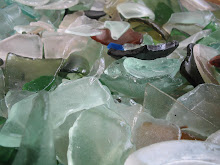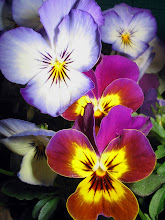
Regular readers will recognise this book - I mentioned it in my recent post on Books I Would Save From a Fire.
 My copy of Gladys Peto's Bedtime Stories belonged to my mother - a Christmas gift from a family friend in 1933. I first made its acquaintance when I was 7 and lying in a darkened room with a bad case of the measles. The illness affected my eyes, so I couldn't read, or even look at pictures, myself. Instead, my mother spent as much of her time as she could reading aloud to me - and once she'd worked through the books on my shelves, she clambered around in the loft and retrieved Enid Blyton's Yellow Fairy Book (but not the one everyone else knows - this was another by the same name and I've never been able to find mention of it, even on eBay), a couple of other story books from the 1930s, My Farm and My Pets, and - most intriguingly of all - Gladys Peto's Bedtime Stories.
My copy of Gladys Peto's Bedtime Stories belonged to my mother - a Christmas gift from a family friend in 1933. I first made its acquaintance when I was 7 and lying in a darkened room with a bad case of the measles. The illness affected my eyes, so I couldn't read, or even look at pictures, myself. Instead, my mother spent as much of her time as she could reading aloud to me - and once she'd worked through the books on my shelves, she clambered around in the loft and retrieved Enid Blyton's Yellow Fairy Book (but not the one everyone else knows - this was another by the same name and I've never been able to find mention of it, even on eBay), a couple of other story books from the 1930s, My Farm and My Pets, and - most intriguingly of all - Gladys Peto's Bedtime Stories. How I loved these stories. They were quirky and weird and unlike any stories I'd heard before. My mother - who had been a Miss Read-type village schoolteacher before I came along - was (and is) absolutely brilliant at reading to children. The characters in the stories came alive - most of them rather spoilt, upper middle-class, Home Counties girls, with bobbed hair, home from boarding school for the hols.
How I loved these stories. They were quirky and weird and unlike any stories I'd heard before. My mother - who had been a Miss Read-type village schoolteacher before I came along - was (and is) absolutely brilliant at reading to children. The characters in the stories came alive - most of them rather spoilt, upper middle-class, Home Counties girls, with bobbed hair, home from boarding school for the hols. But the adventures in Peto's stories were as far removed from my staple Famous Five and Secret Seven stories as could be. No adventures on rafts and in smugglers' caves for these young ladies - oh no. Here were encounters with mermaids and strange old women who were (or maybe they weren't) really witches, a shopkeeper with a sheep's head, flying topiary, secret rooms, talking white rabbits garlanded with flowers. Surreal rather than merely whimsical, Peto's world made a kind of sense once you'd surrendered to it.
But the adventures in Peto's stories were as far removed from my staple Famous Five and Secret Seven stories as could be. No adventures on rafts and in smugglers' caves for these young ladies - oh no. Here were encounters with mermaids and strange old women who were (or maybe they weren't) really witches, a shopkeeper with a sheep's head, flying topiary, secret rooms, talking white rabbits garlanded with flowers. Surreal rather than merely whimsical, Peto's world made a kind of sense once you'd surrendered to it. The tales are so ingrained in my childhood memories that it is difficult for me to read them afresh and assess them dispassionately.
The tales are so ingrained in my childhood memories that it is difficult for me to read them afresh and assess them dispassionately. Once I'd recovered from the measles and the curtains were opened once more, of course I discovered the sheer joy of the illustrations. Sinuous, long-legged children, in stylish, fashion-plate costumes, populate the pictures in a languid and detached manner. The subtle, carefully co-ordinated colours seemed quite alien back then in the psychedelic 1960s; the penmanship was, even to my childish eyes, something quite special and different from anything I'd encountered in children's books before. What intrigued me most was the way that every picture quivered on the brink of bursting into flower. Stylised flowers appear everywhere, gratuitously - they clamber over dresses, drift across furniture, burst through floorboards, and lodge in odd corners of nearly every picture, as if they simply can't keep away.
 It's really no exaggeration to say that - young though I was when I spent hours poring over them - Peto's illustrations changed the way I looked at the world around me and inspired an interest in patterns, textiles and illustration.
It's really no exaggeration to say that - young though I was when I spent hours poring over them - Peto's illustrations changed the way I looked at the world around me and inspired an interest in patterns, textiles and illustration. What a joy it was when my grandmother donated some (then) ancient clothes to the Dressing-Up Box, to recognise in the fabrics similar stylised floral designs. (Oh Lord - supposing they'd been genuine Peto designs that ended up sodden at the bottom of the garden or cut up to make clothes for Sindy!! Ghastly thought.). From that point on, I could spot a 1920s/30s textile design a mile away - and in my own more - ahem - 'sinuous' days, I loved to find, adapt and wear 'vintage' clothing from that era.

I'd never bothered to find out more about the author/artist of this special book, but a bit of Googling recently has revealed that Gladys Emma Peto (1890-1977), worked as an artist, fashion designer and illustrator of books for children, including (like this one) collections of stories which she wrote herself. Her advertising illustrations for Ovaltine and many other well-known products were seen everywhere on posters and in magazines and she also designed pottery, textiles and dresses.
After school, she studied at the London School of Art. Later, in the 1920s, with her husband, who was in the Royal Army Medical Corps, she travelled to Malta, Cyprus and Egypt. Her drawings, paintings and writing from this period were published in J M Dent’s ‘Outward Bound Library’.
 Peto’s Wikipedia entry is short but give some interesting background and reveals her to be quite ahead of her time in commercial terms: what follows is a quote from the Wiki page:
Peto’s Wikipedia entry is short but give some interesting background and reveals her to be quite ahead of her time in commercial terms: what follows is a quote from the Wiki page:
“Sometime in the 1920s the Empire Annual for Australian Girls published ‘Poster Art Work for Girls, A Talk With Miss Gladys Peto the Well-Known Poster Artist.’ Peto there discusses her beginnings. Her family was not especially artistic, except for herself. As a girl in Maidenhead, she would go out ‘in her father's trap’ and notice interesting people along the way. She would get home and sketch them. From thence to High School then Art School. After a few years learning academic techniques, she approached her various editors and publishers with her sketches expecting instant success. She didn't find it, but sold two little drawings. It was a beginning. ‘And [her] family's somewhat discouraging queries as to how I was going to live on that amount did not debar [her] from trying further.’ In keeping with the Empire Annual's mandate to offer guidance, Peto informs the interviewer that a girl with training, talent and inventiveness might well be able to make her way as a commercial artist: ‘there is a good living to be made from this particular type of artistic endeavor.’ No figures are mentioned, but it is noted that ‘several people are aware that this young lady, as one of the best-known depicters of ‘fashionable life,’ and a designer of posters which attract much public attention, makes an annual income which many men in very high positions might well envy.’”
Hope you enjoy these pics (it was difficult to decide which ones to scan!) - click on them to enlarge.

I'd never bothered to find out more about the author/artist of this special book, but a bit of Googling recently has revealed that Gladys Emma Peto (1890-1977), worked as an artist, fashion designer and illustrator of books for children, including (like this one) collections of stories which she wrote herself. Her advertising illustrations for Ovaltine and many other well-known products were seen everywhere on posters and in magazines and she also designed pottery, textiles and dresses.
After school, she studied at the London School of Art. Later, in the 1920s, with her husband, who was in the Royal Army Medical Corps, she travelled to Malta, Cyprus and Egypt. Her drawings, paintings and writing from this period were published in J M Dent’s ‘Outward Bound Library’.
 Peto’s Wikipedia entry is short but give some interesting background and reveals her to be quite ahead of her time in commercial terms: what follows is a quote from the Wiki page:
Peto’s Wikipedia entry is short but give some interesting background and reveals her to be quite ahead of her time in commercial terms: what follows is a quote from the Wiki page: “Sometime in the 1920s the Empire Annual for Australian Girls published ‘Poster Art Work for Girls, A Talk With Miss Gladys Peto the Well-Known Poster Artist.’ Peto there discusses her beginnings. Her family was not especially artistic, except for herself. As a girl in Maidenhead, she would go out ‘in her father's trap’ and notice interesting people along the way. She would get home and sketch them. From thence to High School then Art School. After a few years learning academic techniques, she approached her various editors and publishers with her sketches expecting instant success. She didn't find it, but sold two little drawings. It was a beginning. ‘And [her] family's somewhat discouraging queries as to how I was going to live on that amount did not debar [her] from trying further.’ In keeping with the Empire Annual's mandate to offer guidance, Peto informs the interviewer that a girl with training, talent and inventiveness might well be able to make her way as a commercial artist: ‘there is a good living to be made from this particular type of artistic endeavor.’ No figures are mentioned, but it is noted that ‘several people are aware that this young lady, as one of the best-known depicters of ‘fashionable life,’ and a designer of posters which attract much public attention, makes an annual income which many men in very high positions might well envy.’”
Hope you enjoy these pics (it was difficult to decide which ones to scan!) - click on them to enlarge.





















13 comments:
What an inspiring post, J. I want to rush out and find some Gladys Peto books, to own some of those glorious illustrations. Thank you for your enthusiastic and informative insight into the work of the illustrator, I'm just .... wowed!
Just look at the gorgeous knitted jumpers the two boys are wearing in the next to last picture! I want one!
Pleased you liked it, M! I've a post about an older and pretty much forgotten children's book illustrator up my sleeve for one day soon (wish there were more hours in the day!)
Cath - I know - they're far too good for little boys!
Utter gorgeousness!
An excellent post, I am a big fan of the drawings of the 1930's. The Girl's Own Paper and Woman's Magazine's illustrator Anne Rochester is one of my favourites.Teresa
Hi. I actually wrote that Wikipedia article on GEP from which you quote. Glad to see someone is reading it! I'm (obviously) a fellow Peto fan and I found your post here after one of my periodic Google searches to see if there was any new info out there. I posted some more images and information on her and some pictures on my own blog in Nov. Dec. 2005. I will try to post a link. I hope you will check those out. Not sure how to direct you exactly to those posts but if you look at the archives in my blog you should find them or search blogger. Hope you find them interesting. I was happy to read about your interests and see the scans.
Hi kvelk - thanks so much for getting in touch. I just found your posts - what a lot you have found out about GEP! I confess to having known very little about her until I did my own bit of Googling before putting together this post. Thanks for the Wiki article, too, and do let me know if you post anything else about her. I'll keep an eye on your blog from now on!
Hi there,
I have just purchased a beautiful book by Gladys Peto from my local church fete, 50 pence bought me a copy of 'The Four Leaved Clover'. Outstanding! I can fully appreciate why this author and illustrator would have such a profound effect on you as a child, beautifully realised illustrations that are truly evocative of the time, very art deco, remins me a lot of Aubrey Beardsley!
I have always as a graphic designer loved illustration, this is the first time I have come across the work of Gladys, truly inspiring!
Mark- Southampton
Hi Mark - Thanks for your comment. Until I started blogging I'd never seen or heard of any other Gladys Peto books, but people soon put me right on that. Hope you have also found the definitive Gladys Peto blog at http://julietdoyle.blogspot.com/2008/03/glady-peto-online.html and also some good stuff here http://lasthouse.blogspot.com/search?q=peto
I have a collection of Petoiana. My mother was her god-daughter and wrote her obituary in the Times. I'd like to contact Juliet Doyle, this blog writer, but don't see a way to do so. I am trying to rreactivate my old blog on this site in case bloggers can communicate with each other. No luck so far (password assistance email not arrived). Perhaps you could post advice, Juliet.
I'm trying to get in touch with two blogs about Gladys Peto, this one and 'Last House in Vermont'. Have now revived my old blog, www.binsted-discoveries.blogspot.com. perhaps you could leave a message on it, Juliet? though this seems very cumbersome. Emma Tristram
Emma - you can email me at juliet[at]doyleandco.net
Post a Comment